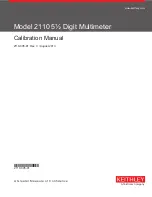
Accuracy calculations
The information below discusses how to calculate accuracy for both DC and AC characteris-
tics.
Calculating DC characteristics accuracy
DC characteristics accuracy is calculated as follows:
Accuracy = ±(ppm of r ppm of range)
(ppm = parts per million, and 10ppm = 0.001%)
As an example of how to calculate the actual reading limits, assume that you are measuring
5V on the 10V range. You can compute the reading limit range from one-year DCV accuracy
specifications as follows:
Accuracy = ±(30ppm of r 5ppm of range)
±[(30ppm
×
5V) + (5ppm
×
10V)]
±(150µV + 50µV)
±200µV
Thus, the actual reading range is: 5V± 200µV, or from 4.9998V to 5.0002V
DC current and resistance calculations are performed in exactly the same manner using the
pertinent specifications, ranges, and input signal values.
Calculating AC characteristics accuracy
AC characteristics accuracy is calculated similarly, except that AC specifications are given as
follows:
Accuracy = ±(% of r % of range)
As an example of how to calculate the actual reading limits, assume that you are measuring
120V, 60Hz on the 750V range. You can compute the reading limit range from ACV one-year
accuracy specifications as follows:
Accuracy = ±(0.06% of r 0.03% of range)
±[(0.0006
×
120V) + (0.0003
×
750V)]
±(0.072V + 0.225V)
±0.297V
In this case, the actual reading range is: 120V ± 0.297V, or from 119.703V to 120.297V
AC current calculations are performed in exactly the same manner using the pertinent speci-
fications, ranges, and input signal values.
Specifications
A-7
Summary of Contents for 2000
Page 1: ...Model 2000Multimeter Calibration Manual A G R E A T E R M E A S U R E O F C O N F I D E N C E ...
Page 10: ...1 Performance Verification ...
Page 23: ...2 Calibration ...
Page 45: ...3 Calibration CommandReference ...
Page 65: ...A Specifications ...
Page 76: ...A 12 Specifications ...
Page 77: ...B Error Messages ...
Page 80: ...C Calibration Program ...
















































